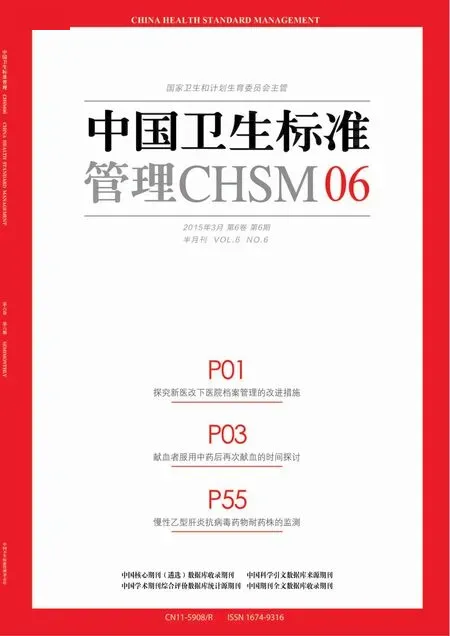肝癌介入治疗中肝动脉狭窄闭塞及肝外侧支血管对肝癌供血的观察分析
【摘要】 目的 研究和观察肝癌介入治疗中肝动脉狭窄闭塞及肝外侧支血管对肝癌供血的意义。方法 收集行肝癌介入治疗的患者共368例,对患者的临床资料进行回顾性分析,总结和研究肝动脉狭窄或闭塞及肝外侧支血管的发生率和部位。结果 368例肝癌患者当中,有17例患者出现了肝动脉狭窄闭塞,主要是由于操作不当和重复导管化疗导致。而形成肝外侧支血管的是胃左动脉血管和右膈下动脉血管,此外胃十二指肠动脉、胰十二指肠下动脉以及肠系膜上动脉均参与了肝外侧支血管的形成。结论 肝动脉出现狭窄或闭塞后,肝外侧支血管就成为了肝肿瘤主要的供血动脉,因此全面地了解和掌握肝外侧支血管的发生率及发生部位对于提高肝癌患者的治疗效果有着重要的意义。
【关键字】肝癌介入治疗;肝动脉狭窄闭塞;肝外侧支血管;肝癌供血
doi:10.3969/j.issn.1674-9316.2015.06.131
工作单位:117021辽宁省本溪市中心医院
Hepatic Artery Stenosis Occlusion in Interventional Therapy of Liver Cancer and Liver Lateral Vascular Observation Analysis of the Blood Supply of Liver Cancer
LI Zhi Benxi center hospital of Liaoning province,Benxi 117021,China
【Abstract】
Objective To study and observe the interventional treatment of hepatic artery stenosis occlusion of liver cancer and liver lateral branch blood vessels of the meaning of blood supply of liver cancer. Methods To collect a total of 368 cases of interventional therapy of liver cancer patients,the clinical data of patients were retrospectively analyzed,summarized and the research of hepatic artery stenosis or occlusion and the incidence of hepatic lateral branch and parts. Results Among 368 patients with liver cancer,there are 17 patients appeared occlusion of the hepatic artery stenosis,mainly due to improper operation and repeated catheter chemotherapy. And form the hepatic artery of lateral branch is left gastric artery and right phrenic artery,moreover under the gastroduodenal artery,pancreatic duodenal artery and superior mesenteric artery were involved in the extrahepatic collateral vessels formation. Conclusion After hepatic artery stenosis or occlusion,extrahepatic vascular became the main blood supply artery of liver tumors,thus comprehensively understand and grasp the incidence of hepatic lateral branch and location to improve the effect of the treatment of patients with liver cancer has important significance.
【Key words】Interventional Treatment for Hepatocellular carcinoma,Hepatic artery stenosis and occlusion,Extrahepatic collateral vessels,Blood supply of liver cancer
1 资料与方法
1.1 一般资料
选取2010年10月至2014年12月期间,我院收治并行肝癌介入治疗的患者共368例,对其临床资料进行回顾性分析。有17例患者出现了肝动脉狭窄或闭塞,其中,男13例,女4例;年龄在35~75岁之间,平均年龄为(49.3±10.3)岁。17例患者中2例为弥漫型肝癌,6例为多中心型肝癌,9例为巨块型肝癌。其中3例经手术证实,3例经肝穿刺活检证实,11例经CT、B超以及生化检查证实。
1.2 方法
17例患者均通过Seldinger技术进行介入治疗和血管造影。选用5F肝动脉管进行腹腔动脉DSA,摄影为4帧/秒,对给肿瘤供血的门静脉和动脉进行细致观察。对17例肝动脉出现闭塞或狭窄的患者进行胃左动脉血管和右膈下动脉血管以及肠系膜上动脉血管的探查,从而对肝外侧支动脉血管来源进行进一步确定 [1]。
为患者行超选侧支动脉的介入治疗和血管造影。如果超选困难,通过微导管进行超选栓塞治疗,使用的栓塞物为混合剂,是阿霉素或表阿霉素和超液态碘化油 [2-3]。
2 结果
368例肝癌患者当中,有17例患者出现了肝动脉的狭窄或闭塞,发生率为4.6%。其中肝动脉狭窄患者有10例,肝动脉闭塞患者有7例。17例患者当中有3例患者是由于肝癌手术导致的肝动脉狭窄或闭塞,其余14例患者是由于导管化疗导致的肝动脉狭窄或闭塞。而在这14例患者当中,有64.3%(9例)的患者是由于3次以上的导管治疗或操作不当而造成的动脉血管闭塞或狭窄,1例患者是因为明胶海绵肝固有动脉栓塞造成的动脉血管闭塞或狭窄。
研究发现,肝动脉狭窄或闭塞后,侧支血管的发生部位主要是:右膈下动脉7例(41.2%),胃左动脉5例(29.4%),胃十二指肠动脉2例(11.8%),胰十二指肠下动脉2例(11.8%),以及肠系膜上动脉1例(5.9%)。进一步细化分析表明,13例肝右叶出现肿瘤的患者,其肿瘤主要的侧支血管包括了右膈下动脉、胰十二指肠下动脉、胃十二指肠动脉以及肠系膜上动脉;而肝左叶出现肿瘤的患者,其肿瘤主要的侧支血管是右膈下动脉。
3 讨论
有研究发现侧支血管的发生频率最高的是胃左动脉和右膈下动脉,这与本研究的结果一致。本次研究中发现,侧支血管的发生部位主要是右膈下动脉7例(41.2%),胃左动脉5例(29.4%),两者一共为12例(70.6%)。而胃十二指肠动脉2例(11.8%),胰十二指肠下动脉2例(11.8%),侧支血管发生频率次之 [4]。胃十二指肠动脉与胰十二指肠下动脉均为胆总管周围动脉,该部位的侧支血管是通过胰头部的弓状动脉形成,一般胰十二指肠下动脉的发生率较高,本研究中该部位与胃十二指肠动脉的发生率一样,因此应该寻求更大的例数和更广的研究范围。
综上所述,肝动脉出现狭窄或闭塞后,肝外侧支血管就成为了肝肿瘤主要的供血动脉,因此全面地了解和掌握肝外侧支血管的发生率及发生部位对于提高肝癌患者的治疗效果有着重要的意义。

